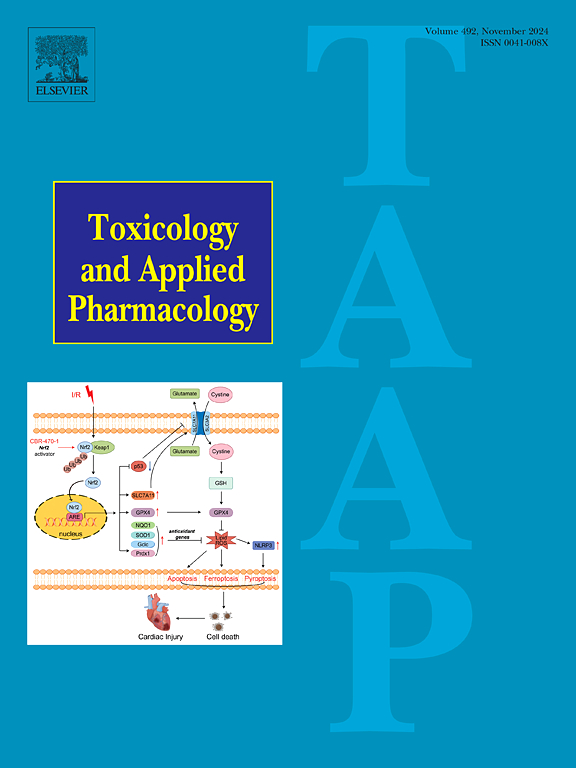Effect of parental perinatal exposure to L-glutamate monosodium salt monohydrate on developmental neurotoxicity in rat offspring
IF 3.3
3区 医学
Q2 PHARMACOLOGY & PHARMACY
引用次数: 0
Abstract
This study aimed to provide preliminary information about the potential adverse effects of L-Glutamate Monosodium Salt Monohydrate on maternal health and offspring development, particularly about developmental neurotoxicity and abnormal behavior in offspring after oral administration by gavage to female SD rats during the perinatal stage. The study involved administering different doses of L-glutamate monosodium salt monohydrate to four groups, including a vehicle control group. The doses were given orally via gavage from gestation day 6 (GD6) until postnatal day 21 (PND21) at levels of 6000, 3000, and 1000 mg/kg BW. The study found that parental exposure to L-Glutamate Monosodium Salt Monohydrate at a dose of 6000 mg/kg BW had adverse effects on the growth and development of the offspring. These effects included delayed physical development and reflex development. However, no effects on dams were observed. The Lowest Observed Adverse Effect Level (LOAEL) for developmental toxicity to the offspring is 6000 mg/kg BW, and the No Observed Adverse Effect Level (NOAEL) is 3000 mg/kg BW. Additionally, the NOAEL for maternal toxicity is considered to be 6000 mg/kg BW.
父母围产期暴露于l -谷氨酸钠一水合物对大鼠后代发育神经毒性的影响。
本研究旨在初步了解l -谷氨酸钠盐对母体健康和子代发育的潜在不良影响,特别是围产期雌性SD大鼠口服灌胃后对子代发育神经毒性和异常行为的影响。该研究将不同剂量的l -谷氨酸钠盐一水合物分配给四组,包括一个载体对照组。从妊娠第6天(GD6)到出生后第21天(PND21),剂量分别为6000、3000和1000 mg/kg BW。本研究发现,亲代以6000 mg/kg BW的剂量暴露于l -谷氨酸钠盐一水合物对后代的生长发育有不利影响。这些影响包括身体发育和反射发育的延迟。然而,没有观察到对水坝的影响。对后代发育毒性的最低观察不良影响水平(LOAEL)为6000 mg/kg BW,无观察不良影响水平(NOAEL)为3000 mg/kg BW。此外,母体毒性的NOAEL被认为为6000 mg/kg BW。
本文章由计算机程序翻译,如有差异,请以英文原文为准。
求助全文
约1分钟内获得全文
求助全文
来源期刊
CiteScore
6.80
自引率
2.60%
发文量
309
审稿时长
32 days
期刊介绍:
Toxicology and Applied Pharmacology publishes original scientific research of relevance to animals or humans pertaining to the action of chemicals, drugs, or chemically-defined natural products.
Regular articles address mechanistic approaches to physiological, pharmacologic, biochemical, cellular, or molecular understanding of toxicologic/pathologic lesions and to methods used to describe these responses. Safety Science articles address outstanding state-of-the-art preclinical and human translational characterization of drug and chemical safety employing cutting-edge science. Highly significant Regulatory Safety Science articles will also be considered in this category. Papers concerned with alternatives to the use of experimental animals are encouraged.
Short articles report on high impact studies of broad interest to readers of TAAP that would benefit from rapid publication. These articles should contain no more than a combined total of four figures and tables. Authors should include in their cover letter the justification for consideration of their manuscript as a short article.

 求助内容:
求助内容: 应助结果提醒方式:
应助结果提醒方式:


